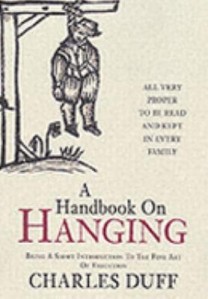Review: A Handbook on Hanging September 10, 2010
Author: Beach Combing | in : Contemporary, Modern , trackback Beachcombing recently stumbled upon and cannot now shut up about Charles Duff’s A Handbook on Hanging: Being a Short Introduction to the Fine Art of Execution (1928) in a Nonsuch reprint.* Yes, it gives a caricature of the history of hanging, while also communicating the case for and against abolition back in the days when the debate was still open in the UK. But mainly and bizarrely it is a comedy written in thunderous ‘olde’ Empire tones.
Beachcombing recently stumbled upon and cannot now shut up about Charles Duff’s A Handbook on Hanging: Being a Short Introduction to the Fine Art of Execution (1928) in a Nonsuch reprint.* Yes, it gives a caricature of the history of hanging, while also communicating the case for and against abolition back in the days when the debate was still open in the UK. But mainly and bizarrely it is a comedy written in thunderous ‘olde’ Empire tones.
Beachcombing laughed out loud on several occasions, a rare event. But can the reader blame him? The Handbook’s chapter headings include: ‘Sheer beauty of hanging’; ‘English neck-breaking the best’, ‘Always hang women’, ‘Still more mistakes of hangmen’, ‘Hanging, flogging, war and sadism’ etc etc.
Here too is an author who asserts, without the hint of a smile, that the Royal Ulster Constabulary, doctors and hangmen alone have the right to kill repeatedly. And who mentions Cologne with the hissed aside ‘or Köln as the Germans persist in calling it’.
There is then, beyond this, an almost surreal darker humour (of the laughing or medical kind?) that seeps through. So Duff makes the case for supplying the soon-to-die with snakes and ladders sets. There is also a remarkable passage where he advocates broadcasting hangings live on the radio:
The crack like a muffled shot of a small pistol which indicates the official breaking of the criminal’s neck ought to be broadcast; when the neck is not broken, listeners would hear the squelch of strangulation – which would tell its own story. Ex-hangmen could be employed by the British Broadcasting Corporation to provide colour and background to the details and noises transmitted through the ether. They might even be commissioned to give us an occasional twenty minutes’ Talk in an egg-head programme on so intensely interesting a subject. In Britain it would have to be a straight Talk, but in the United States it could, in some places, (where hanging holds the field against electrocution) be a sponsored programme, and possibly interspersed with advertising for rope, dope, and other consumer goods such as we see on television. (57)
So is this all a joke or was the author serious?
Well, Duff defends hanging as a particularly British art-form – claiming, for example, that the American hangman at Nuremburg was far inferior to Pierrepont who hung for England in the internment camps after the war. Yet he deploys his arguments in such a ridiculous but lovable style – ‘I was surprised to find that so humane a man as Charles Dickens did not altogether approve of hanging’ – and places enough contrary facts that he was presumably an abolitionist himself.
Certainly anyone coming away from the book would feel a little queasy about state-sanctioned killing: botched executions, drop heights, guillotines going wrong, the merits and demerits of beheading and execution. But the author keeps a straight face throughout – think Johnny Swift on eating Irish babies – and in Beachcombing’s great grandchildren’s time this book could easily be read as the work of a Colonel Blimp figure who meant every damn word he said.
If you want to learn about hanging generally and particularly hanging in English history then read Richard Clark’s outstanding Capital Punishment in Britain. However, if you have a spot of flu – Beachcombing is coming down… – and want to read a book in the English comic tradition of How to be an Alien or Adrian Mole then this could be for you.
Beachcombing would dearly love to write something on Duff himself but has found little of moment. Can anyone help out? Drbeachcombing AT yahoo DOT com
*Note this is a reprint of the 1961 edition, the most complete


